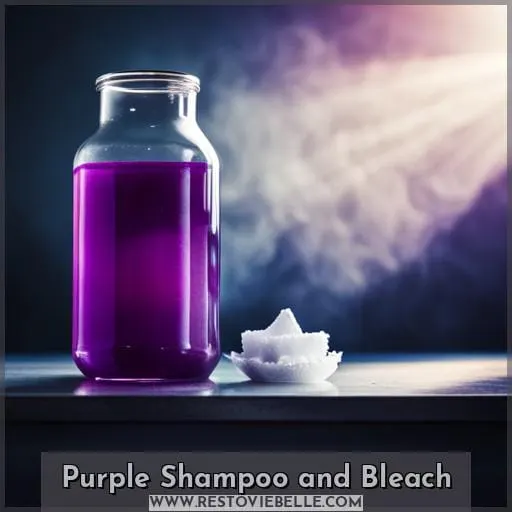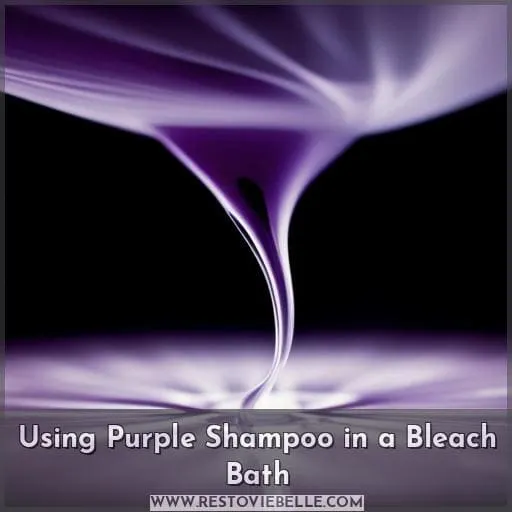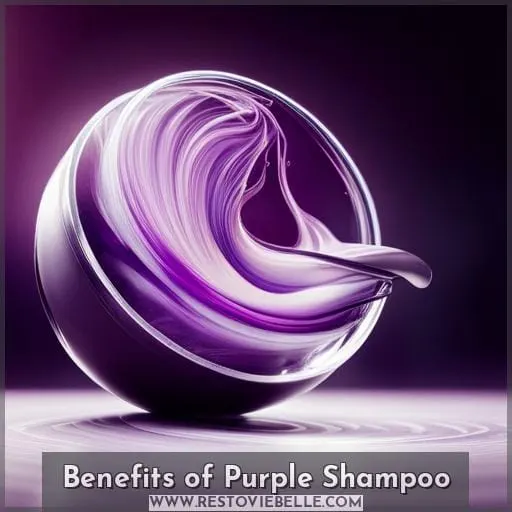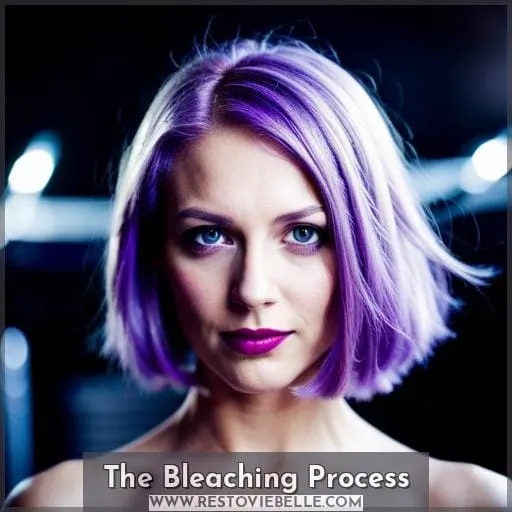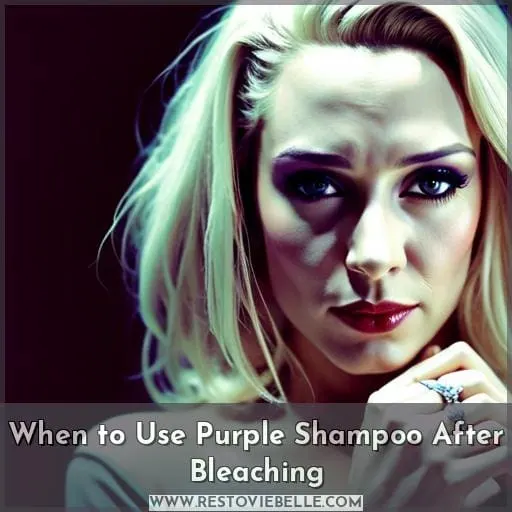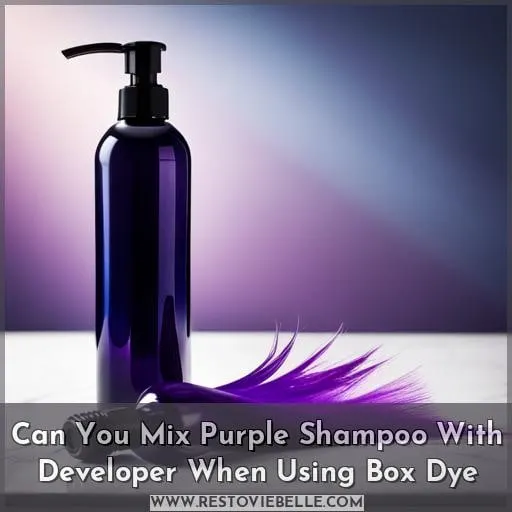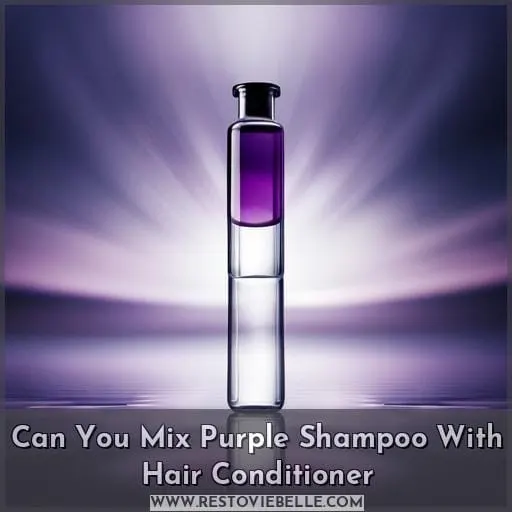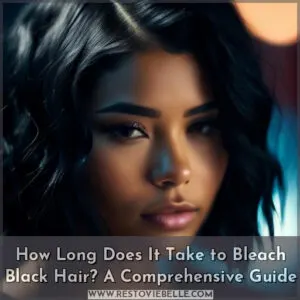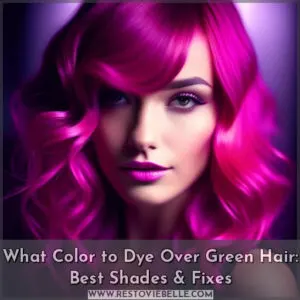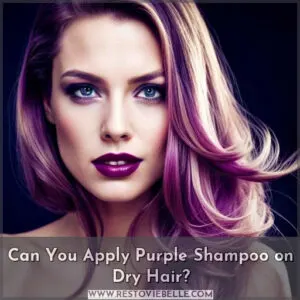This site is supported by our readers. We may earn a commission, at no cost to you, if you purchase through links.
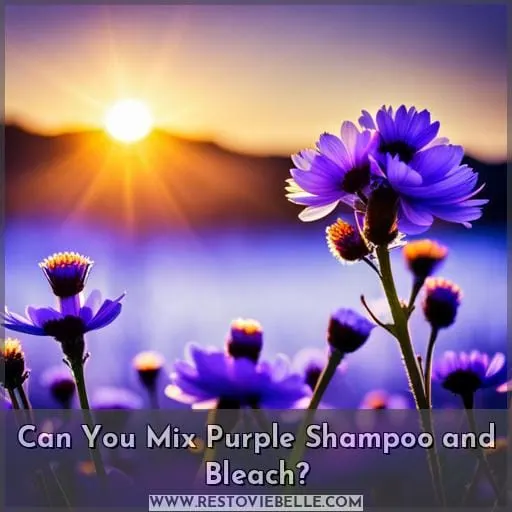 Dreaming of a new hair color but dreading the damage from bleach? You’re not alone. Can you mix purple shampoo with bleach to get your desired hue without wrecking your locks? The answer is complicated, and it’s important to know what you’re getting into before embarking on any bleaching journey.
Dreaming of a new hair color but dreading the damage from bleach? You’re not alone. Can you mix purple shampoo with bleach to get your desired hue without wrecking your locks? The answer is complicated, and it’s important to know what you’re getting into before embarking on any bleaching journey.
In this article, we’ll discuss the effects of mixing purple shampoo with bleach and other related topics so that you can make an informed decision when dyeing or lightening your hair.
Table Of Contents
Key Takeaways
- Mixing purple shampoo with bleach is not recommended.
- Purple shampoo is designed for toning and should not be mixed with bleach.
- Quality salt sprays or masks are better alternatives to bleach baths.
- Proper care and waiting a few days before using toner or dye on bleached hair is crucial.
Purple Shampoo and Bleach
Mixing purple shampoo with bleach is not recommended, but it can still be useful for toning previously bleached hair. Bleaching your hair can cause damage, and using purple shampoo in combination with this process helps to counteract yellow hues that may result.
Mixing Purple Shampoo With Bleach is Not Recommended
Mixing purple shampoo and bleach isn’t a good idea because it can damage your hair. It’s best to tone bleached locks using other methods. One option is to use bleach baths instead of traditional bleaching, as they are safer.
Another consideration is to avoid mixtures that can cause clumping or over-drying. Instead of mixing purple shampoo with conditioner, it’s recommended to use alternatives like quality salt sprays and masks.
Seeking professional advice can also help in finding the safest way to lighten your hair at home without causing damage. Ultimately, proper care is crucial for achieving desired results while keeping your hair healthy from root to tip.
Purple Shampoo is Used to Tone Previously Bleached Hair
Toning your previously bleached hair with purple shampoo can be a cost-effective way to maintain color. One application of purple shampoo is just as effective in neutralizing yellow hues as two applications of regular bleach.
Purple shampoo formulations are specially designed for toning and should not be used in DIY bleach baths due to dilution, as they overpower the purple pigments. Bleach baths require mixing with developer and applying to wet hair instead, thus shortening the exposure time for less damage compared to traditional bleaching methods.
If you’re looking for something other than purple shampoo, quality salt sprays or masks are better alternatives.
Bleaching Can Damage Hair, Making Purple Shampoo Useful to Counteract Yellow Hues
When you’ve bleached your hair, using purple shampoo can help counteract the yellow hues and keep it looking vibrant.
- Use purple shampoo shortly after bleaching for best results.
- Quality salt sprays or masks can be better alternatives to bleach baths.
- Tone unbleached hair with a diluted mixture of purple shampoo and water occasionally.
- Avoid mixing developer with purple shampoo when using box dye on already lightened locks – this may lead to clumping or more damage from chemicals!
- In order to prevent further damage, consult a professional if unsure about any steps in the process of toning your mane!
Using Purple Shampoo in a Bleach Bath
Are you considering lightening your hair with a bleach bath? You should know that purple shampoo is not effective in this method due to dilution. Bleach baths are a gentler way of lightening hair than traditional bleaching, which involves mixing the bleach with shampoo and applying it to wet hair.
Purple Shampoo is Not Effective in a Bleach Bath Due to Dilution
Using purple shampoo in a bleach bath won’t work as intended because it will be too diluted. A bleach bath involves mixing bleaching powder with shampoo and applying the mixture to wet hair for lightening effects.
However, due to dilution, the purple pigments of the shampoo are overpowered by those of the bleach, making it ineffective for toning purposes. It’s safer to perform a regular bleaching process first before using separate purple shampoo on dry hair strands for better results.
To prevent damage from over-tone or color corrections, try using quality salt sprays or masks instead.
Bleach Baths Are a Gentler Way to Lighten Hair Compared to Traditional Bleaching
Comparing traditional bleaching to a bleach bath, you’ll find that the latter is much easier on your hair. Bleach baths use diluted bleach and a shampoo mix for lightening, and toning with purple shampoo afterwards helps maintain color for longer.
Safety measures must be followed when preparing a bath – wear gloves and avoid wearing contact lenses! Be aware that the effectiveness of purple shampoo can be lessened due to dilution in this process.
The benefits include reducing brassy tones or over-toned hair without damaging it like regular bleaching does.
Bleach Baths Involve Mixing Bleach With Shampoo and Applying It to Wet Hair
To create a bleach bath, you will need to mix bleach and shampoo together before applying it to wet hair. Take into consideration the dilution effects of this technique; although it still lightens strands, it is gentler compared to traditional bleaching methods.
When performed correctly, finding the right balance between the strength of the product and the duration of application will minimize the risk of over-processing or damaging your hair. Prioritize safety by conducting a patch test beforehand and using low-number developers whenever possible.
Keep in mind that if you have dark hair, multiple sessions may be required to achieve the desired results.
Benefits of Purple Shampoo
Looking to elevate your hair color game? Purple shampoo is the solution! Not only does it neutralize copper and orange-red tones in your hair, but its deoxidation effect reduces yellow and red pigments.
Additionally, this special shampoo enhances cool tones like blue, silver, or gray for added intensity.
Purple Shampoo Neutralizes Copper and Orange-red Tones in Hair
By applying purple shampoo, you can effectively neutralize copper and orange-red tones in your hair. Cleanse the strands with this product to remove brassiness and restore coolness to any color. It’s a great way of toning without using bleach, as it won’t cause damage like traditional lightening methods.
Purple shampoo will also correct color mistakes or give an extra boost of vibrancy for colored locks.
For best results when combating unwanted warm hues in the hair shafts, use purple shampoo regularly instead of mixing it with bleach for ultimate protection and natural beauty!
Purple Shampoo Has a De-oxidation Effect, Reducing Yellow and Red Pigments
Using purple shampoo can help reduce yellow and red pigments, leaving your hair looking brighter than before. Its de-oxidation effect helps to tone unwanted colors while also strengthening the effectiveness of other toning agents.
The presence of purple pigments in the shampoo works to neutralize orange and copper tones, resulting in improved color enhancement for cooler shades such as blue, silver, or gray.
In addition to its toning benefits, using a quality purple shampoo on bleached hair will add back lost moisture while protecting against further damage from harsh chemicals like bleach.
It Enhances Color Intensity for Cool Tones Like Blue, Silver, or Gray
You’ll love the vibrancy of cool tones like blue, silver, or gray enhanced by purple shampoo! This miracle product not only reduces yellow and red pigments in hair but also increases color intensity for these cooler shades.
Purple shampoo benefits are numerous; from protecting dyed locks to energizing dull strands with its deep violet pigment. As an added bonus, it’s important to note that purple shampoo shouldn’t be mixed with bleach as this can lead to adverse reactions and further hair damage.
Keep using this powerful product regularly for results you’ll love!
The Bleaching Process
Taking the plunge into bleaching your hair? Be sure to prepare with the right products and tools, such as bleach powder, developer, a dye comb, gloves, and more. Then, apply bleach from the ends up towards the roots before rinsing with pH-balanced shampoo, followed by conditioner for the best results.
Prepare for Bleaching With the Right Tools and Products
To achieve optimal results, it’s essential to equip yourself with the right tools and products before bleaching your hair.
Bleaching essentials include bleach powder, developer, a dye comb, and gloves for protection.
Shampoo and conditioner must be pH balanced to minimize damage to strands, while a mixing bowl allows you to combine ingredients precisely.
A shower cap keeps bleach away from the scalp and clothing, while towels are used for clean up afterwards.
Adding purple shampoo into the mix offers additional benefits, such as neutralizing copper tones in tresses or enhancing cool colors like silver or gray hues.
Preparing beforehand provides ideal conditions that ensure desired end-results when the hair lightening adventure is complete!
Apply Bleach Starting From the Ends and Moving Towards the Roots
Gently start applying the bleach mixture from the ends of your hair and move it towards your roots. Take extra care to avoid contact with the scalp as this can cause irritation or even burns.
When you reach the root area, use a dye comb to spread the product evenly through each section for maximum coverage. Doing so will help protect your locks while also ensuring that all parts receive equal bleaching power for uniform results.
Regularly apply purple shampoo afterwards to maintain color vibrancy and prevent brassy tones from appearing in lightened hair! For best results, wait at least two weeks between bleach applications.
Rinse With PH-balanced Shampoo and Use Conditioner
After bleaching, be sure to rinse your hair with a pH-balanced shampoo and use conditioner to keep it healthy.
PH-balanced shampoos are important for restoring the natural balance of moisture in your hair after using harsh chemicals. Conditioning helps lock in that hydration while preventing damage from overprocessing.
Post-bleach care is also vital. Toners help neutralize any residual brassiness or yellow tones, while purple shampoo can be used every week as part of an ongoing maintenance routine.
Mixing these two products together should always be avoided. Not only will they cancel each other out, but they can also lead to further damage due to chemical reactions!
For best results, stick with separate applications. Rinse off bleach wash first before applying toner or dye. Then, opt for regular use of a quality purple shampoo and conditioner combo afterwards.
When to Use Purple Shampoo After Bleaching
After bleaching your hair, it’s important to give the cuticles time to open before using toner or dye. To keep your color vibrant and long-lasting, use a diluted purple shampoo every week – just mix 2 parts water with 1 part shampoo! Doing this will help maintain dyed hair color without overdrying strands.
Wait a Few Days to Allow Hair Cuticles to Open for Toner or Dye Absorption
Allow your hair cuticles time to open up after bleaching so that toner or dye can be absorbed more effectively. For optimal results, wait between two weeks and one month before applying any color treatments.
Proper hair preparation prior to bleaching is also crucial for a successful coloring session.
After the bleach has been applied, avoid using purple shampoo immediately. Wait until the cuticle layers have opened up properly and are ready for new pigments.
Use Purple Shampoo Weekly to Maintain Dyed Hair Color
To keep your colored hair looking fresh, use purple shampoo once a week. Dilution techniques can help soften the intensity of the product and preserve its benefits.
When applied correctly, it will control brassiness and retain color while giving you that desired shine. Purple shampoo is an excellent way to maintain dyed hair color without drying out your locks or causing further damage to them.
To make sure no harm comes from over-dosing on this product, dilute with water (2:1) before applying weekly maintenance treatments.
Dilute Purple Shampoo With Water (2:1) if Necessary
If your hair needs a little extra toning, try diluting purple shampoo with water (2:1) for more subtle results. The benefits of this approach include using bleach safely, combating brassiness, and increasing the effectiveness of a bleach bath.
When applying purple shampoo to unbleached hair or after bleaching, use diluted versions for better color-correcting without over-drying. For best results on dyed or bleached hair, leave the mixture in your strands up to 15 minutes before rinsing thoroughly under running water followed by conditioner if needed.
Purple shampoo dilution can be used as part of an effective maintenance routine that keeps cool tones vibrant and corrects any brassy hues without damage from undiluted products – so you can keep looking great!
Can You Mix Purple Shampoo With Developer When Using Box Dye
Mixing purple shampoo with developer when using box dye is not recommended. It can cause hair damage and clumping. For best results, avoid combining the two products as it can have damaging consequences for your hair health.
Mixing Purple Shampoo With Developer When Using Box Dye is Not Recommended
Mixing purple shampoo with developer when using box dye is not recommended, as it can lead to hair damage and clumping. When dealing with chemical treatments such as dyes, it’s better to use products separately for best results.
Developer and purple shampoo should not be mixed together due to potential reactions that may cause further damage or discoloration of hair. Instead, opt for alternative bleaching methods such as salt sprays or masks, which are safer options compared to traditional bleach baths.
For those looking to tone their tresses without the risk of unwanted repercussions, a quality toner applied after washing will do the job just fine! With these precautions in place, you’ll be able to enjoy your new look while keeping your locks healthy too!
It Can Lead to Hair Damage and Clumping
Using purple shampoo with developer when box dyeing can lead to hair damage and clumping. Mixing the two together dilutes the purple shampoo concentration, making it much less effective in toning bleached hair.
This results in an uneven distribution of color on your locks, resulting in a blotchy or mottled appearance that is difficult to fix without starting again from scratch.
Furthermore, as the mixture dries out your scalp and strands more quickly than usual due to its drying effect, it increases the chances of breakage and split ends appearing over time if you don’t take measures such as using restorative deep conditioning treatments afterwards.
To avoid these issues altogether, opt for using either product individually rather than combining them – unless you have consulted a professional beforehand who recommends otherwise!
Can You Mix Purple Shampoo With Hair Conditioner
Mixing purple shampoo with hair conditioner is generally not recommended as it can over-dry your hair. However, if you’re feeling adventurous and cautious at the same time, then you may consider trying this out occasionally.
Mixing Purple Shampoo With Hair Conditioner is Generally Not Recommended
Trying out a mixture of purple shampoo and hair conditioner may not be the best idea, as it can often lead to over-dried locks. Mixing these two products can have consequences for your hair hydration levels, so it’s important to consider their compatibility before combining them.
Alternatives like quality salt sprays or masks are generally safer and more beneficial for bleached or colored hair.
For maintaining color intensity, using the right type of purple shampoo is key; choose one that matches your current shade while also noting how frequently you need to use it on unbleached hairs.
Ultimately, keep in mind that professional advice should always be sought if you’re looking into lightening treatments such as bleaching processes – safety first!
- Consider product compatibility when mixing purple shampoo with conditioner
- Quality salt sprays and masks are better alternatives than mixtures
- Chemical reactions from combining with bleach may cause damage
- Choose appropriate type of Purple Shampoo based on current shade & frequency needed
It May Over-dry Hair, but Can Be Tried Occasionally With Caution
Despite the potential risk of over-drying, it’s worth a shot to experiment with purple shampoo and conditioner every now and then for optimal hair health. Using a dilution technique like mixing 2 parts water with 1 part shampoo can help reduce the amount of product used, minimizing any drying effects.
However, if you’re looking for alternatives or more consistent results, quality salt sprays and masks are better suited for bleached hair. It’s important to exercise caution when using such products as they may still cause damage if used too frequently or in excess amounts.
If you decide to try this method occasionally, be sure to test it on a small area first before regular use!
Conclusion
Like a ray of sunshine breaking through the clouds, purple shampoo can be a powerful tool in your hair care arsenal. It can help you achieve the look you want without damaging your hair, from neutralizing brassy tones to restoring color intensity.
But when it comes to mixing purple shampoo and bleach, proceed with caution. Bleaching can be harsh on your hair, and mixing purple shampoo with bleach can be even worse.
It’s always best to use shampoo and bleach separately for hair care. Experiment with purple shampoo at home, but for best results, consult a professional to help you lighten and tone your hair safely and effectively.

